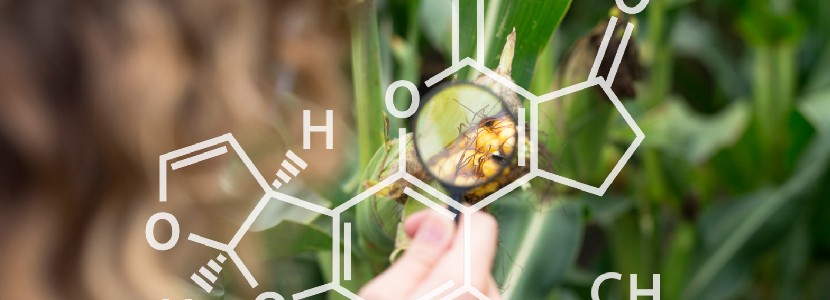Aflatoxins constitute a family of secondary metabolites produced mainly by Aspergillus flavus and Aspergillus parasiticus. Aflatoxins are known to affect important foods, including oilseeds and cereals.
Aflatoxins comprise aflatoxin B1, B2, G1, G2, M1 and M2 in which AFB1 shows increased toxicity in addition to causing immunosuppression, carcinogenicity, teratogenicity and mutagenicity (Bhat et al., 2010).
The secretion of aflatoxin AFB1 depends on abiotic factors such as:
- humidity
- temperature
- oxidative stress
- storage, etc. (Astoreca et al. , 2014).
| The toxicity of AFB1 in animals varies by age, sex and species, as well as the dose and duration of exposure to this toxin (Dhanasekaran et al. , 2011). |
- In poultry, the immune system is severely affcted by AFB1, resulting in reduced subsets of the T-cell population (Jian et al. , 2015)
Pierron et al. (2016) found that dietary exposure to AFB1 in pigs resulted in altered lymphocyte activation, a negative influence on vaccine efficacy, and a delayed cell-mediated immune response.
- Several disorders in livestock associated with aflatoxicosis have been reported including the birth of small calves, diarrhea, mastitis, respiratory problems, rectal prolapse, etc. (Applebaum et al., 1982)
The toxicity of AFB1 in dairy cows has a double importance, since it affects the anima’s performance and leads to milk contamination being of great concern for human food.
Prevention of aflatoxicosis with the use of dietary supplements
[register] There are numerous anti-AFB1 agents reported, but the ease of application for many of the documented alternatives is questionable.
- Most herbal extracts and essential oils with remarkable anti-AFB1 activity are not commercially viable due to raw material limitations such as quantity, quality consistency, and/or processing complexities.
For an anti-AFB1 agent to be effective, it is essential for it to have:
- Food safety
- High bioavailability
- Liver and immune protective functions
- Feasible extraction methods for commercial manufacturing
Table 1 includes the most common dietary anti-AFB1 agents.
In this review, we will attempt to delve into the protective effects of selenium and curcumin that fit the criteria for effective anti-AFB1 aflatoxin dietary agents.
Selenium
Selenium comes in organic and inorganic forms. It is present in inorganic form as selenites and selenates and in organic form as selenoamino acids, selenopeptides and selenoproteins.
Inorganic selenium is converted by plants into selenomethionine, which is converted to selenocysteine in animals via trans-sulfuration. Selenocysteine is transformed into selenophosphate by selenophosphate synthase (Reich et al., 2016).
The specific biochemical role of selenium is as a functional component of the mammalian antioxidant enzyme glutathione peroxidase (GPx).
¡Check out nutriNews Latam’s exlusive mineral tables here!
- Selenium meduated anti-AFB1 protection in poultry
Supplementation with selenium (sodium selenite) in feed contaminated with AFB1 (0.4 mg/kg) restored populations of T-cell subtypes. This report also revealed an important finding, that excess selenium in the chicken diet resulted in adverse immunological effects with weakened T-cell immunity.
- Selenium mediated anti -AFB1 protection in pigs
Unlike poultry, selenium-mediated protection after exposure to AFB1 has not been reported.
Hao et al. (2016) demonstrated that selenium methionine (SelMet) protected AFB1-challenged porcine splenocytes by improving the expression of mRNA and glutathione peroxidase 1 (GPx1), selenoprotein S (SelS), and thioredoxin reductase 1 proteins.
Selenium supplementation in animal feed
Organic selenium in animal feed is found in the form of:
- Selenometionina (SeMet)
- Metilselenocisteína (MeSeMet)
- Selenium proteinate (Se proteinate)
- Selenized yeast (Se’s yeast)
The inclusion of Inorganic Se in animal feed is still a common practice mainly due to the lower cost compared to organic selenium.
- The interaction of Se with other minerals and vitamins
- Low transfer efficiency to milk, eggs and meat
- Inability to form Se reserves in the organism
- Resulting excretion due to inefficient intestinal absorption
- It is reduced due to the reducing environment of storage conditions or in the digestive tract
Curcumin: a hepatic protector phytochemical
It is shown that AFB1, after enzymatic activation, causes oxidative stress in living cells. Therefore, substances with antioxidant properties have been shown to be effective in improving AFB1-induced oxidation.
Turmeric is a homemade spice with medicinal properties. It is used in the Indian subcontinent and Southeast Asia. It is also widely used in traditional Indian and Chinese medicine since ancient times.
Curcumin is a widely studied antioxidant agent. Many studies have documented the application of this compound to improve cancer-related damage and carcinogenesis.
Curcumin helps maintain the antioxidant status of cells by eliminating free radicals, inhibiting oxidative enzymes, activating catalases, and inducing de novo glutathione synthesis (El-Agamy et al., 2010).
¡Check out nutriNews Latam’s exclusive phytogenic tables here!
Curcumin protected the kidney of mice affected by AFB1 by asignificantly increasing the content of ascorbic acid and glutathione content and decreasing lipid peroxidation.
- In this study, mice were exposed to low and high doses of AFB1 (750 and 1500 μg/kg body weight) with 2 mg/0.2 mL of olive oil/animal/day of pure curcumin.
Oral administration of curcumin in rats was also shown to restrict oxidative damage in the liver mediated by AFB1. In addition, it significantly improved the antioxidant status of the liver by increasing levels of hepatic GSH, as well as antioxidant enzymes (SOD, CAT, and GSH-Px) (El-Agamy et al., 2010).
Conclusions
There has been steady progress of research in developing effective nutritional supplements that can efficiently address mycotoxin and specifically aflatoxins’ contamination without compromising nutrients.
Anti-AFB1 aflatoxins dietary supplements have attracted significant attention due to the acute toxicity of AFB1, and also due to the fact that many of these supplements do not pose significant food safety concerns.
The application of selenium in animal feed to prevent aflatoxicosis is a growing discipline with promising reports in birds. In the case of pigs, in vitro results in splenocytes are promising with a high potential for in vivo toxin exposure studies.
Moreover, curcumin has been shown to be a potent enhancing agent that counteracts AFB1-mediated oxidative liver damage by inhibiting the hepatic activation of this mycotoxin to toxic metabolites.
[/register]
